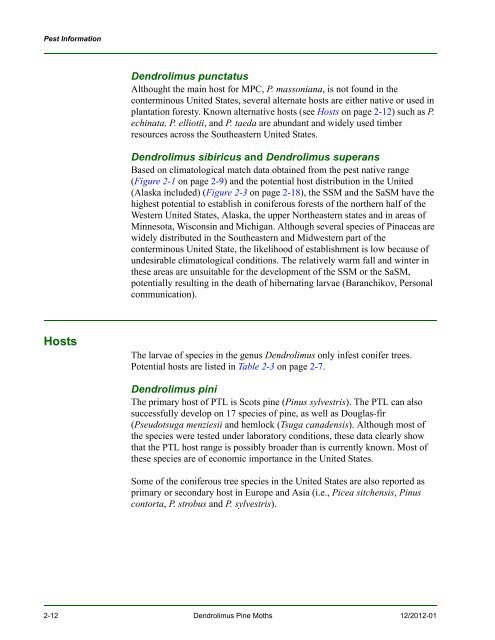New Pest Response Guidelines - aphis - US Department of Agriculture
New Pest Response Guidelines - aphis - US Department of Agriculture
New Pest Response Guidelines - aphis - US Department of Agriculture
You also want an ePaper? Increase the reach of your titles
YUMPU automatically turns print PDFs into web optimized ePapers that Google loves.
<strong>Pest</strong> Information<br />
Hosts<br />
Dendrolimus punctatus<br />
Althought the main host for MPC, P. massoniana, is not found in the<br />
conterminous United States, several alternate hosts are either native or used in<br />
plantation foresty. Known alternative hosts (see Hosts on page 2-12) such as P.<br />
echinata, P. elliotii, and P. taeda are abundant and widely used timber<br />
resources across the Southeastern United States.<br />
Dendrolimus sibiricus and Dendrolimus superans<br />
Based on climatological match data obtained from the pest native range<br />
(Figure 2-1 on page 2-9) and the potential host distribution in the United<br />
(Alaska included) (Figure 2-3 on page 2-18), the SSM and the SaSM have the<br />
highest potential to establish in coniferous forests <strong>of</strong> the northern half <strong>of</strong> the<br />
Western United States, Alaska, the upper Northeastern states and in areas <strong>of</strong><br />
Minnesota, Wisconsin and Michigan. Although several species <strong>of</strong> Pinaceas are<br />
widely distributed in the Southeastern and Midwestern part <strong>of</strong> the<br />
conterminous United State, the likelihood <strong>of</strong> establishment is low because <strong>of</strong><br />
undesirable climatological conditions. The relatively warm fall and winter in<br />
these areas are unsuitable for the development <strong>of</strong> the SSM or the SaSM,<br />
potentially resulting in the death <strong>of</strong> hibernating larvae (Baranchikov, Personal<br />
communication).<br />
The larvae <strong>of</strong> species in the genus Dendrolimus only infest conifer trees.<br />
Potential hosts are listed in Table 2-3 on page 2-7.<br />
Dendrolimus pini<br />
The primary host <strong>of</strong> PTL is Scots pine (Pinus sylvestris). The PTL can also<br />
successfully develop on 17 species <strong>of</strong> pine, as well as Douglas-fir<br />
(Pseudotsuga menziesii and hemlock (Tsuga canadensis). Although most <strong>of</strong><br />
the species were tested under laboratory conditions, these data clearly show<br />
that the PTL host range is possibly broader than is currently known. Most <strong>of</strong><br />
these species are <strong>of</strong> economic importance in the United States.<br />
Some <strong>of</strong> the coniferous tree species in the United States are also reported as<br />
primary or secondary host in Europe and Asia (i.e., Picea sitchensis, Pinus<br />
contorta, P. strobus and P. sylvestris).<br />
2-12 Dendrolimus Pine Moths 12/2012-01

















